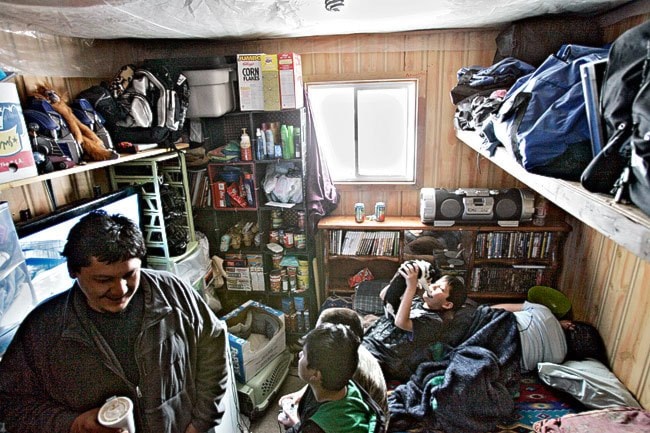De Beers Canada’s Victor Mine, located in the James Bay area of northern Ontario, was named “Mine of the Year” by Mining Magazine in 2009. Victor is a diamond mine, which, according to its webpage, “injected approximately $474 million directly into the Canadian economy” last year.
The Victor Mine is built on the land of the James Bay Cree. Just 90 kilometres away lies the community of Attawapiskat where, three weeks ago, chief and council declared a state of emergency because of substandard housing.
So far, no senior official, elected or otherwise, from either the federal or provincial government, has dropped in to review the situation.
Whole families in Attawapiskat are crowded into shacks and tents, four-bedroom houses hold 20 to 30 people. The community has electricity, but many of the dwellings are unserviced except by an extension cord. People carry their water in plastic pails and dump their sewage in a roadside ditch. Overcrowding makes the woodstoves dangerous and several children have been badly scalded. The fire risk is high, sanitation is poor, health is bad, suicide is epidemic.
The citizens of Attawapiskat can hardy be surprised at government indifference toward their state of emergency. Their elementary school was condemned in 2000 because of diesel fumes and still hasn’t been replaced. In 2007, the local Grade 8 class caught the nation’s attention with their Education is a Human Right campaign, particularly when 14-year-old activist Shannen Koostachin was nominated for the International Children’s Peace Prize. Faced with a barrage of negative publicity, the federal government pledged to build a school.
Tragically, Shannen Koostachin and her mentor Rose Thornton died in a traffic accident after Shannen had left her community to attend school in southern Ontario. Whether it was because of the loss of that strong activist voice, or just because of the public’s short attention span, whatever pressure the government felt appears to have eased, and the school went back on hold.
Kids in Attawapiskat are still leaving their crowded shacks and wall tents to walk to run-down portable classrooms that sit along the edge of the old condemned site.
It costs a lot of money to build a school in a remote place like James Bay, but not nearly so much as it costs to build, for instance, a diamond mine. The question arises, if a mine is so promising that it’s worth spending $1 billion on startup costs, how much should the company be willing to spend to lift the local community, on whose land their mine squats, out of poverty? If the mine puts $500 million into the Canadian economy each year, why can’t Canada find the money to bring James Bay out of the Third World?
De Beers has a department of “social investment,” which “addresses sustainability issues relevant and material to our key stakeholders in the area of economics, ethics, employees, communities and environment.” To that end “$5.9 million was invested through cash, in-kind and staff time” toward literacy and education in nearby communities, and a chunk of the mine’s spending was directed toward aboriginal-owned companies. These amounts were negotiated under “impact-benefit agreements” with surrounding First Nations.
In February 2009, the same year Victor was the Mine of the Year, citizens of Attawapiskat blockaded the mine road to demand that their impact-benefit agreement be revisited. Spokesperson Greg Shisheesh put the matter very clearly: “We are committed to ensuring that our people benefit directly. We are poor and we need to get out of the poverty we are in.”
Nearly three years later, not much has changed. People in Attawapiskat are now saying the housing crisis is so severe they should be evacuated, at least for the winter. If that were to happen, it would carry a tragic echo of another of De Beer’s projects, the Gope deposit in Botswana.
At De Beer’s request, almost the entire population of Kalahari Bushmen, 100,000 people, were driven from their homeland in the Cental Kalahari Game Reserve to clear the way for a future mine. In a decade, a traditional hunter-gatherer culture that had survived for millennia was gone, and the Bushmen were living in shanty towns and relocation centres, plagued by poverty, alcohol and disease.
This is not to suggest that the Cree should stand their ground so their children can freeze in wall tents this winter. If the people have no choice but to leave, Canada, Ontario, and De Beers should all be helping to facilitate a humane relocation, and a swift return to a rebuilt community. But the shame will be ours, that for years Canada let Attawapiskat deteriorate to the point where it’s unfit for human habitation while strangers got rich on Cree diamonds.
Al Pope won the Ma Murray Award for Best Columnist in BC/Yukon in 2010 and 2002. His novel, Bad Latitudes, is available in bookstores.
